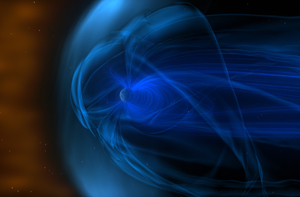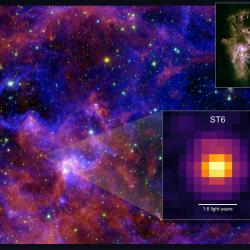UMD-led Study Shows How Earth Slows the Solar Wind to a Gentle Breeze
NASA satellite data reveals electron-scale energy transformation at the leading edge of Earth’s magnetic field
As Earth orbits the sun at supersonic speed, it cuts a path through the solar wind. This fast stream of charged particles, or plasma, launched from the sun’s outer layers would bombard Earth's atmosphere if not for the protection of Earth's magnetic field.
 Just as a motorboat creates a bow-shaped wave ahead of itself as the hull pushes through the water, Earth creates a similar effect—called a bow shock—as it pushes through the solar wind. Scientists have sought to explain how Earth’s magnetic field can shove aside the powerful solar wind without unleashing calamity. They have known part of the answer for a long time: the bow shock converts energy from the solar wind to heat stored in electrons and ions. But now, researchers have important new clues about how this process occurs.
Just as a motorboat creates a bow-shaped wave ahead of itself as the hull pushes through the water, Earth creates a similar effect—called a bow shock—as it pushes through the solar wind. Scientists have sought to explain how Earth’s magnetic field can shove aside the powerful solar wind without unleashing calamity. They have known part of the answer for a long time: the bow shock converts energy from the solar wind to heat stored in electrons and ions. But now, researchers have important new clues about how this process occurs.
A University of Maryland-led study describes the first observations of the process of electron heating in Earth’s bow shock. The researchers found that when the electrons in the solar wind encounter the bow shock, they momentarily accelerate to such a high speed that the electron stream becomes unstable and breaks down. This breakdown process robs the electrons of their high speed and converts the energy to heat.
The results add an important new dimension to scientists’ understanding of Earth’s magnetic field and its ability to protect the planet from harmful particles and radiation. The research paper was published in the journal Physical Review Letters on May 31, 2018.
"If you were to stand on a mountaintop, you might get knocked over by a fast wind," explained Li-Jen Chen, lead author of the study and an associate research scientist in the UMD Department of Astronomy. "Fortunately, as the solar wind crashes into Earth’s magnetic field, the bow shock protects us by slowing down this wind and changing it to a nice, warm breeze. We now have a better idea how this happens.”
The scientists obtained their data from NASA’s Magnetospheric Multiscale (MMS) mission. The MMS mission consists of four identical satellites that carry instruments to study the physics of Earth’s magnetic field as it interacts with the solar wind. The satellites obtained three-dimensional measurements every 30 milliseconds, resulting in hundreds of measurements within the bow shock layer. These high-frequency, precise measurements from the MMS mission were critical to the study.
“The extremely fast measurements from MMS allowed us finally to see the electron heating process in the thin shock layer,” said Thomas Moore, a senior project scientist at NASA's Goddard Space Flight Center and a co-author of the study. “This is groundbreaking because now we have the ability to identify the mechanism at work, instead of just observing its consequences.”
Scientists have known for some time that the bow shock is somehow able to convert the energy in electrons to heat without any direct collisions between the electrons. This means that friction—a common way to generate heat here on Earth—is not responsible for electron heating in the bow shock.
"The new observations of electron acceleration at the bow shock rewrite the current understanding of electron heating,” said Chen, who is also a research scientist at NASA's Goddard Space Flight Center. "For example, researchers didn't expect that the bow shock could accelerate the solar wind electron stream to the speeds that we observed."
In an earlier phase of the MMS mission, the satellites typically orbited much closer to Earth, so they usually missed the bow shock. However, an unexpected outburst of solar wind pushed the bow shock closer to Earth, allowing the satellites to capture rare and informative data.
Seizing on this advantage, the researchers observed the solar wind’s electron stream before, during and after meeting with the bow shock. The electron stream accelerated by the shock only took 90 milliseconds to destabilize and fully break down.
“The study of electron heating is important not just for understanding how the bow shock protects Earth, but potentially for satellites, space travel and maybe exploring other planets in the future,” Chen said.
By giving the first clear picture of what electrons at the bow shock are doing, Chen and her collaborators hope to encourage other scientists to perform computer simulations, further space observations and laboratory experiments on electron heating. Chen also looks forward to delving further into the mechanisms by which the bow shock accelerates the electron stream.
"Typically, scientists have simulations or theories to predict what is happening and then they design experiments to measure it," Chen said. "This time it's the opposite: the measurement came first. The simulation and theory will have to catch up."
###
Other study co-authors affiliated with the UMD Department of Astronomy include associate research scientist Naoki Bessho, research engineer Levon Avanov and postdoctoral associate Shan Wang.
This work was supported by NASA, the U.S. Department of Energy (Award No. DESC0016278), the U.S. National Science Foundation (Award Nos. AGS-1202537, AGS-1543598 and AGS-1552142), the French Centre National d'Études Spatiales and the French Centre National de la Recherche Scientifique. The content of this article does not necessarily reflect the views of these organizations.
The research paper, "Electron bulk acceleration and thermalization at Earth’s quasi-perpendicular bow shock," Li-Jen Chen et al., was published in the journal Physical Review Letters on May 31, 2018.
Media Relations Contact: Irene Ying, 301-405-5204, zying@umd.edu
University of Maryland
College of Computer, Mathematical, and Natural Sciences
2300 Symons Hall
College Park, MD 20742
www.cmns.umd.edu
@UMDscience
About the College of Computer, Mathematical, and Natural Sciences
The College of Computer, Mathematical, and Natural Sciences at the University of Maryland educates more than 9,000 future scientific leaders in its undergraduate and graduate programs each year. The college’s 10 departments and more than a dozen interdisciplinary research centers foster scientific discovery with annual sponsored research funding exceeding $175 million.







